The Ottawa Senators are entering the 2022-23 season as one of the most exciting teams in the NHL. Their offseason was one of the best in the league, with most analysts agreeing that it should get at least an A grade. The team went from one that finished in the bottom 10 for five seasons to a potential playoff contender seemingly overnight. Although they may be a few seasons away from making an impact in the postseason, the fanbase is more hopeful than they have been in years.
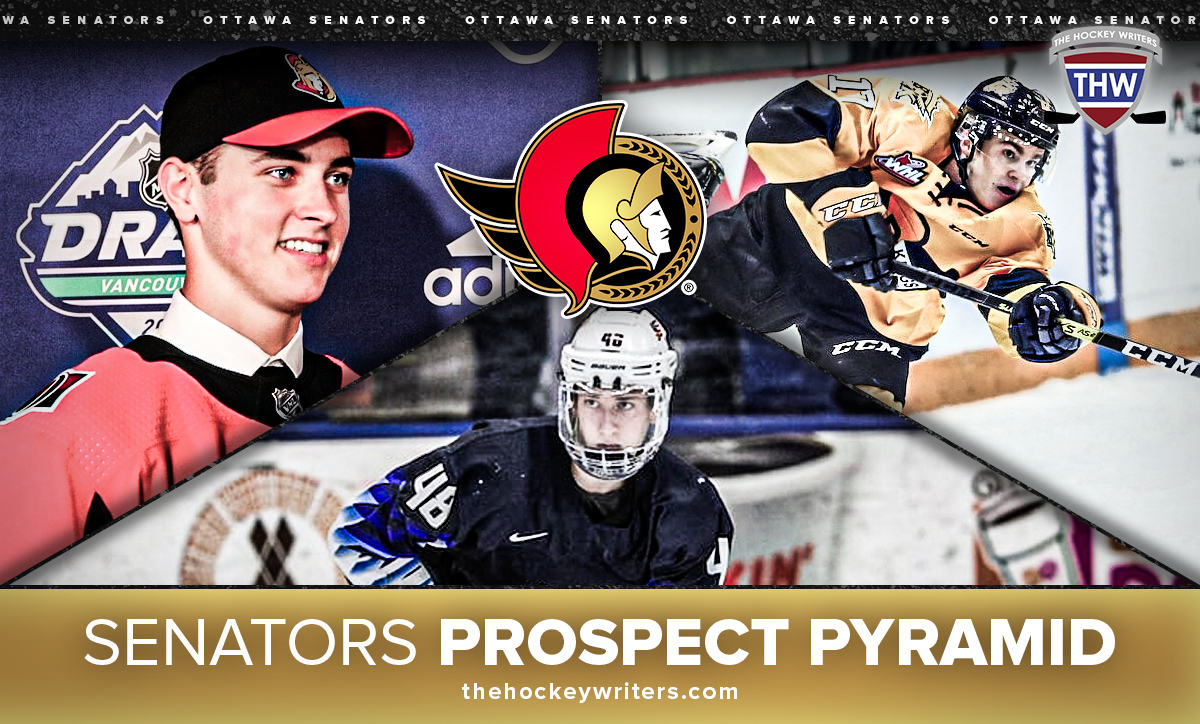
After years of rebuilding, fans are finally seeing the Senators’ top prospects make it into the NHL, which means that the prospect cupboard is looking a bit thinner than in previous years. That doesn’t mean there aren’t talented prospects in the system, though. In Peter Baracchini’s Best Prospect Systems, the Senators came in 14th thanks to some underrated players stepping more into the limelight and showcasing their skills. For a team that wants to win now, however, that’s exactly how it should be. Ottawa’s top selections are living up to their draft day hype, from Brady Tkachuk to Tim Stutzle, and now all they need are the final few pieces to help fill out the roster. As such, bottom-six spots will be hotly contested over the next few seasons thanks to some intriguing prospects in the Senators’ system.
What is a Prospect Pyramid?
Created by YouTuber and Sportsnet correspondent Steve Dangle, the Prospect Pyramid was designed to be a cleaner and less divisive model to rank an organization’s prospects. Sometimes, finding the difference between the team’s 10th and 14th best prospects is so minute that separating the two is a matter of splitting hairs. Hence, the pyramid, where prospects are grouped into tiers according to their NHL potential.
Dangle’s creation has since become the new standard for organizing prospects. Below is a brief description of the six tiers he created, which have been transcribed by THW’s Brandon Share-Cohen.
Tier 1 – Elite talent (Auston Matthews, Connor McDavid-level talent)
Tier 2 – Very, very good prospects with a real chance of being top-six forwards, top-two defenders or good starting goalies
Tier 3 – Good players who fall just short of Tier 2, perhaps due to lower ceilings, but who are distinctly better than tier’s below them
Tier 4 – Distinct shot at making an NHL roster and being a contributor (top-nine forward, bottom-four defender, fringe starter or backup goaltenders)
Tier 5 – Players who likely don’t project to be anything more than a role player in the NHL as their ceiling – these players’ chances of making the NHL aren’t very high compared to their comrades (sometimes due to being relatively unknown at this point)
Tier 6 – Players who are a longshot to make the NHL
Additions, Subtractions & Graduates
Since July 2022, these are the prospects who have been added and left the organization.
Additions
Trades: None
Free Agents: Rourke Chartier, Kristians Rubins, Jake Lucchini, Jacob Larsson
Draft: Filip Nordberg, Oskar Pettersson, Tomas Hamara, Stephen Halliday, Jorian Donovan, Cameron O’Neill, Kevin Reidler, Theo Wallberg, Tyson Dyck
Subtractions
Trades: Filip Gustavsson (Minnesota Wild), Kole Sherwood (Nashville Predators)
Free Agency: Vitali Abramov, Eric Engstrand, Clark Bishop, Zach Senyshyn
Graduates
Played more than 25 games: Alex Formenton, Parker Kelly
Played more than 50 games, overall: None
Tier 1: Empty
I’m always hesitant to put any prospect in tier one. Players here should be the best of the best, and while the Senators have had plenty of supremely talented prospects come through their system, I’m not convinced they’ll be generational talents. Stützle is arguably the closest the Senators have gotten to acquiring one of these players, and even he is right on the border of this tier; I initially placed him in tier two in 2021, then retroactively place him in the top group in 2022. He still doesn’t look like he’ll become a 100-point player, but I think 70-80 points is completely within his realm, as well as becoming a dominant two-way force, similar to Patrice Bergeron.
Tier 2: Jake Sanderson
Jake Sanderson is another fantastic prospect in the Senators’ system and there’s a good argument to be made in placing him in tier one, but I just don’t think he’s quite there. That doesn’t change that he is almost guaranteed to become the Senators’ best defenceman in a few seasons. In one preseason game against the Toronto Maple Leafs, he caught up with Mitch Marner and was able to break up the play, then broke up a two-on-one with a very smart stick check. But maybe the best sign was that, on top of matching up regularly against Marner and John Tavares, he logged the most minutes of any Senators’ blueliner, playing over 21 minutes that night.
The only question is about how he’ll handle a full season in the NHL. Last season, he had two surgeries on his hand, which prevented him from joining the Senators in April, and there was some speculation that he might miss training camp as well. Thankfully, he was back on the ice in September and, so far, doesn’t seem to have lost a step at all after putting up 26 points in 23 games with the University of North Dakota. But the regular season is a different beast, and while some fans think he could put up a similar season to 2022 Calder Trophy winner Moritz Seider, that doesn’t seem to be where the Senators’ two-way defender is headed. Look for him to put up a strong rookie season, likely around 20-30 points, and later emerge into a regular 40-50 point player who logs heavy minutes in all situations.
Tier 3: Shane Pinto, Ridly Greig, Jacob Bernard-Docker, Lassi Thomson, Roby Jarventie, Tomas Hamara, Mads Søgaard
Shane Pinto was expected to claim a spot last season after looking strong in training camp and averaging over 20 minutes a night in his first three games, but a shoulder injury stopped him from playing for the rest of 2021-22. Finally, after nearly a full year, he’s been activated from the injured reserve and looks better than ever. In a preseason game against the Winnipeg Jets, he put up a goal and an assist, both of which looked almost too easy.
Like Sanderson, there’s a good argument that he’s a tier-two prospect, but I have him in tier-three because he doesn’t project to be a first-line center, which I would expect from a top-tier prospect. Pinto will almost certainly emerge as a dangerous secondary offensive threat, manning the second or third lines, but he’ll likely be more valued for his defensive presence. He was, after all, named the NCAA’s Best Defensive Forward in 2021 while playing with North Dakota, where he helped the team win their second national championship. I’d expect him to become a 50-60 point player in the future, potentially taking over for Claude Giroux when his contract expires in 2024-25.
Related: Ottawa Senators’ Best All-Time
Ridly Greig feels like the biggest enigma in the Senators’ organization. When he was drafted 31st overall in 2020, he looked to be a bottom-six player with some offensive skills. His physical, in-your-face brand made him an instant fan favourite and it helped him put up 191 points in 183 games over four seasons with the Brandon Wheat Kings. But he didn’t project to be as impactful at the NHL level, instead filling the role of ultimate pest, which would be greatly welcomed on an increasingly aggravating Senators roster.
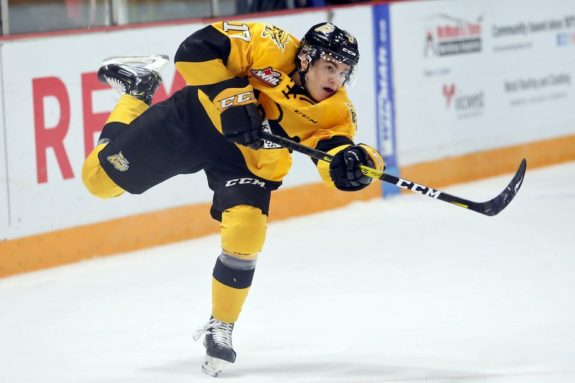
But after the 2022 World Juniors, Greig now seems more like a potential top-line player. On a Canadian team stacked with future NHL stars, he still stood out as one of the team’s best players, putting up three goals and six points in five games before an injury forced him to sit for the last two matches. There is some concern over his recklessness, which has already started to lead to unfortunate injuries and bad penalties. He still looks like a future top-six power winger but will be far more valuable for his aggressiveness and non-stop motor. Look for him to play most of the season in the American Hockey League (AHL) and make a few appearances with the Senators over the year.
The Senators have two fantastic young defencemen in Jacob Bernard-Docker and Lassi Thomson, but they will be hard-pressed to claim a spot on the team’s blue line this season, despite the progress they’ve made over the past few seasons. Both are former first-round selections and shoot right-handed, which gives them a significant advantage at securing a roster spot sooner rather than later, but as of now, the team simply doesn’t have the room.
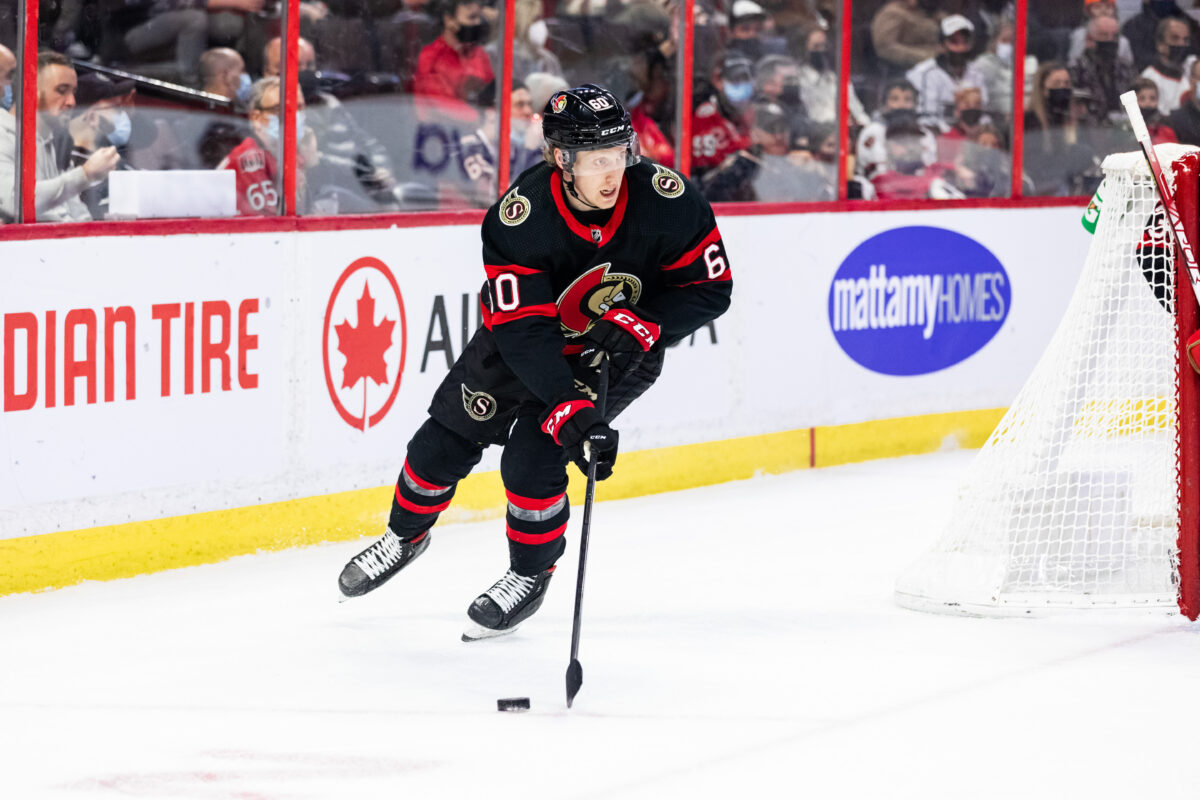
At the moment, Thomson is the more exciting player to watch. In his second AHL season, he finished second among defencemen with 26 points in 44 games and tied for first with 10 goals. He also appeared in 16 NHL games, recorded five assists, and led the team’s defence in Corsi for percentage. While he does struggle with some pacing, especially at the NHL level, that shouldn’t be too much of a problem as he will spend another season developing in the minors.
Related: Ottawa Senators’ 2020-21 Prospect Pyramid
Bernard-Docker didn’t have the same impact as Thomson, putting up just nine points in 58 games during his rookie AHL season, but he still earned a few cups of coffee with the Senators, playing eight games and putting up the first NHL assist of his career. Although generating offence is not his specialty, he was instrumental in North Dakota’s back-to-back Penrose Cups in 2020 and 2021 and is expected to become a top-four defender shortly.
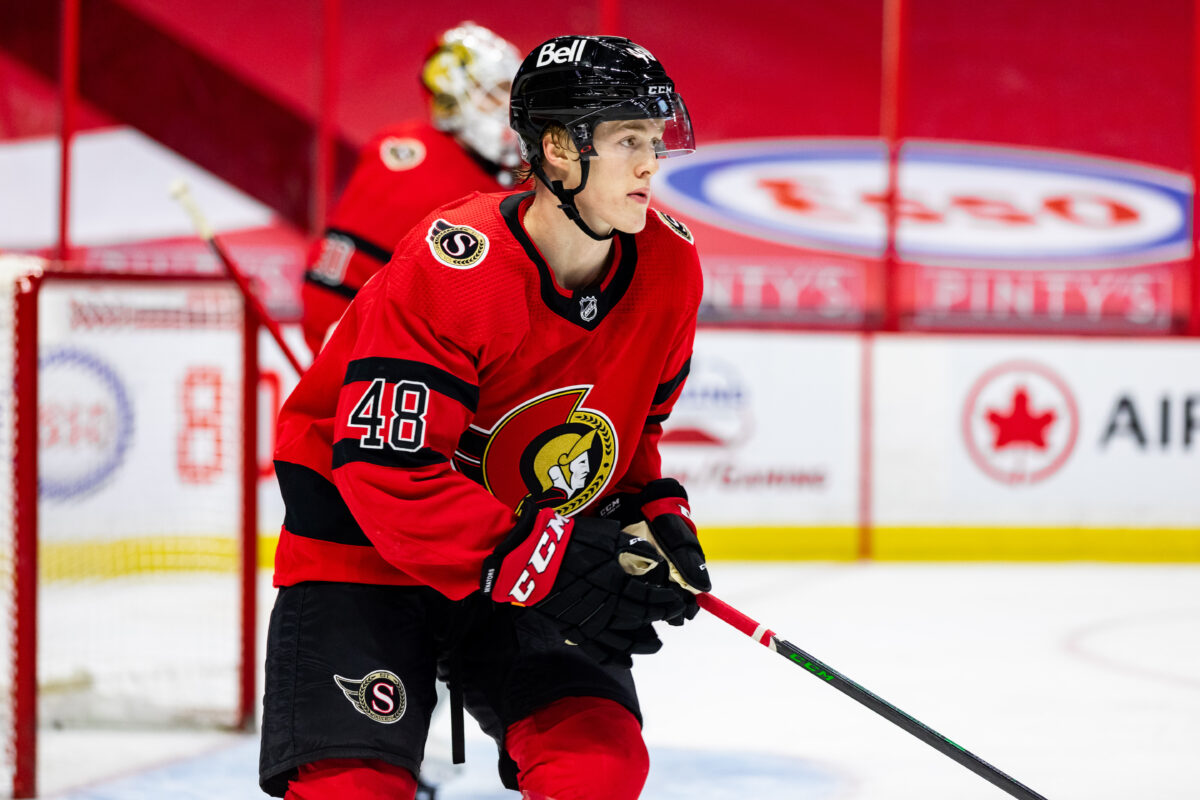
Roby Jarventie is coming off his biggest season to date and looks like a future second-line power forward. The 2020 second-round pick had an incredible 2022 World Juniors where he truly made his mark as a top prospect, scoring four goals and nine points in seven games with Finland. There are some questions about his overall ability, and his four World Juniors goals were all power play markers, but he has speed, a great shot, and will likely be in Ottawa very soon.
Tomas Hamara is arguably the best player from the 2022 Draft class. Selected in the third round, the smooth-skating Czech defender was solid while playing in Finland last season, scoring 25 points in 32 games with Tappara U20. He could certainly evolve into a top-four defenceman in the future, but he’s a long-term project. He’ll spend the next couple of seasons adjusting to the North American game while playing with the Ontario Hockey League’s (OHL) Kitchener Rangers.
Mads Søgaard is the final player in tier three. After trading away Filip Gustavsson, he’s taken over as the Senators’ top goalie prospect and early showings have fans wondering if he could be the team’s future starting goalie, especially after last season, where he took a big step forward in his development. He stopped 27 of 29 shots in his first NHL start to secure a win over the Detroit Red Wings. While his second game didn’t go as well, he put up very solid AHL numbers, posting a .908 save percentage over 35 games with a record of 19-14-1. The 6-foot-7 Dane will need some time to reach his potential, but when he gets there, he could be incredible.
Tier 4: Angus Crookshank, Egor Sokolov, Zack Ostapchuk, Jorian Donovan, Leevi Merilainen, Tyler Kleven, Filip Nordberg, Oskar Pettersson, Viktor Lodin, Philippe Daoust, Jacob Larsson, Tyler Boucher
There is a lot of potential in tier four, and many of them could find themselves moving up next year, but as of now, it’s unclear whether they’ll reach it. Take Angus Crookshank, for example. He was never a point-per-game player with the University of New Hampshire, but after signing his entry-level deal in 2021, he was one of the Belleville Senators’ best players, scoring an impressive 16 points in 19 games. However, a torn ACL kept him out of the entire 2021-22 season. Back to full strength after his injury, he’s been one of the more noticeable forwards in preseason action but is still unlikely to earn a roster spot out of camp. Still, all eyes will be on him as he enters his first full AHL season.
Egor Sokolov is in a similar boat in that he’s got the potential to be a threat in the NHL, but will have a much harder time getting there than some of his contemporaries. In his first two seasons in the AHL, he scored 75 points over 99 games and ranked top-two in team scoring both years. However, his first forays into the NHL last season weren’t as successful; in eight games, he was held pointless and played just over 10 minutes a night on average. He still could make the Senators out of camp in a depth role, but competition will be tough and it’s more likely he returns to the AHL for one more season before securing a spot in the bottom-six.
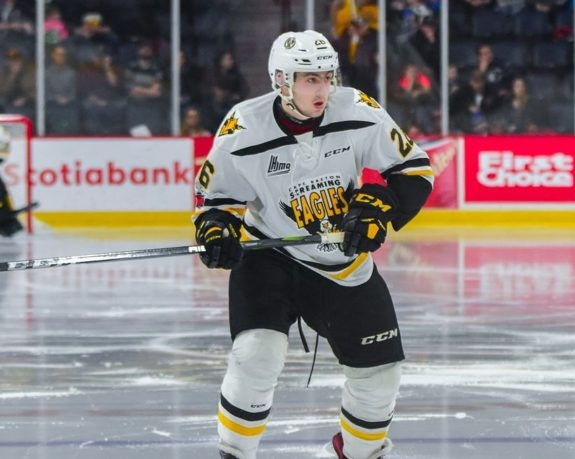
Zack Ostapchuk is slowly becoming one of the Senators’ best picks from 2021. He was unstoppable with the Vancouver Giants in the 2022 Western Hockey League (WHL) playoffs, scoring 23 points in 12 games, and was selected to Canada’s World Junior team at the rescheduled 2022 tournament. A talented sniper and a powerful skater, he’s impressed the Senators’ staff, earning comparisons to Nick Paul. Were the NHL-CHL transfer agreement different, he’d likely be playing in the AHL already.
Jorian Donovan, a fifth-round pick in 2022 and the son of Senators’ development coach Shean Donovan, has looked like a potential top-four defender but is a long way away from reaching it. Due to the OHL shutdown in 2020-21, many 2022 prospects weren’t able to play as 17-year-olds, which put them in an awkward situation where their rookie season was also their draft year. Still, Donovan managed to put up 22 points in 64 games with the Hamilton Bulldogs and is expected to play a much bigger role this season with them.
It’s been fascinating to watch Leevi Merilainen transition from a complete unknown ahead of the 2020 NHL Draft to one of the more promising goalie prospects in the NHL. He was one of just five goalies in the OHL last season to play 50 or more games, and of that group, he finished third with a .891 save percentage (SV%) while posting the second-most wins. He was billed as Finland’s starter for the 2022 World Junior team but was supplanted by backup Juha Jatkola, who was given the start in the gold medal game against Canada. Merilainen is back in Finland this season and while he could become a starting goalie in the NHL, he’ll need some more time to develop.
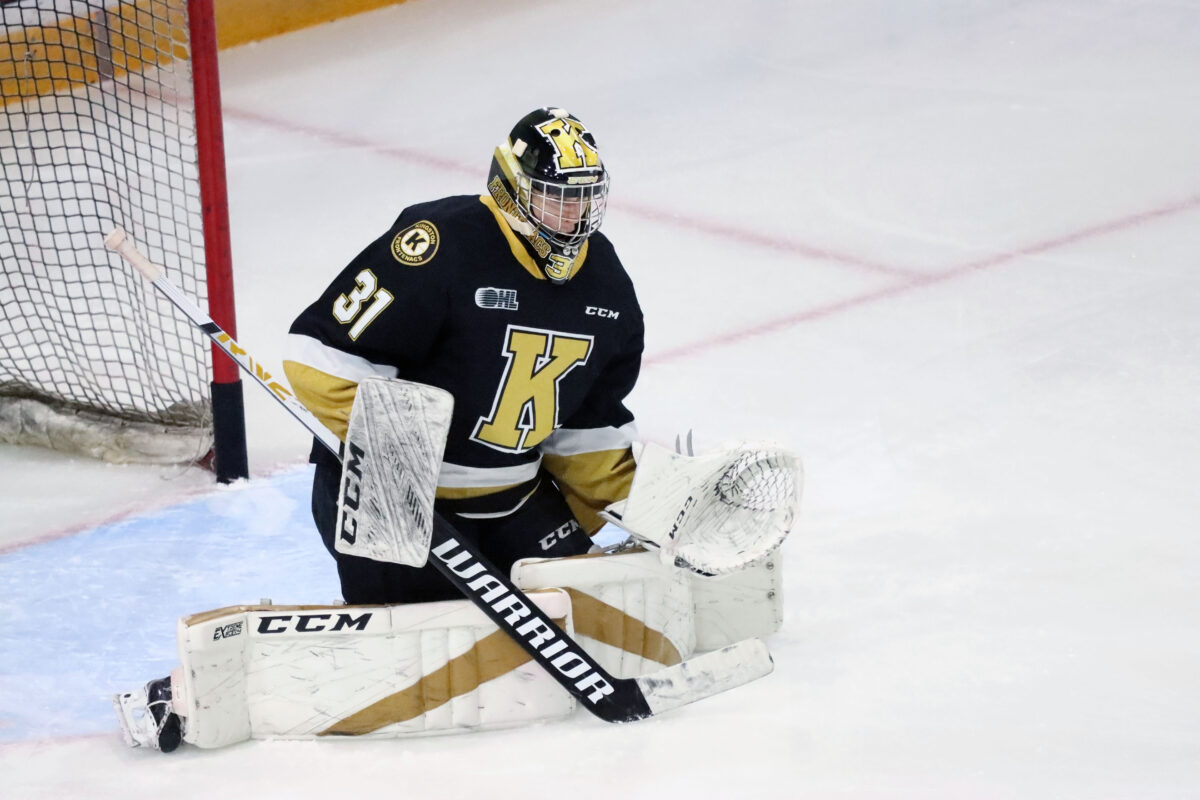
Tyler Kleven is as big and tough as they come. At 6-foot-4 and 201-pounds, he’s been praised for his physicality and defensive awareness, which earned him a spot on both the 2021 and 2022 American World Junior teams. Last season, he utilized his booming slapshot more frequently, which led to him scoring seven goals in 38 games. He’s entering his third season at the University of North Dakota, and while he’s no Zdeno Chara, he could eventually become a Robyn Regehr or Anton Volchenkov-type of player in the Senators’ bottom four when he finally joins the team in a season or two.
If he doesn’t pan out, however, the Senators now have Filip Nordberg in their system. Also 6-foot-4 and over 200 pounds, he’s a fairly typical shut-down defenceman who uses his size and strength to remove players from the puck, but he’s also demonstrated some surprising playmaking abilities. He was a bit of a reach in the second round at the 2022 Draft, but if he pans out, he could be a very solid player for them in the future. He currently plays in Sweden’s U20 league and will likely spend some time this season in the Allsvenskan.
Oskar Pettersson, another one of Ottawa’s third-round selections in 2022, has earned some comparisons to Tomas Holmstrom in that he loves to set up right in front of the net and no force can move him. It’s served him very well too, as he has seven points in seven U20 games this season in Sweden, which earned him a call-up to Rögle BK of the Swedish Hockey League (SHL). It’s always a good sign when a teenager can earn a spot on an SHL roster, even if it’s with limited minutes. He could make his way over to North America in a season or two, and fight for a bottom-six spot soon after.
After his North American debut last season, all eyes will be on Viktor Lodin this season. A fourth-round pick in 2019, he broke out last season in the SHL, scoring 27 points in 43 games with Timrå IK, which was seventh among players aged 23 or younger. He made his way over to the AHL at the end of the SHL season, where he scored five goals and eight points in 10 games and even earned a late-season call-up to the Senators. He’s still a long way away from making the NHL, but there’s middle-six potential there. However, fans will have to wait as he is currently out with an injury, which he suffered after a controversial hit from Montreal Canadians’ forward Arber Xhekaj, who also caused Crookshank’s injury last season.
Philippe Daoust is another promising forward prospect, having never scored less than a point per game in the Quebec Major Junior Hockey League (QMJHL) aside from his rookie season. He was also crucial for the Saint John Sea Dogs in the Memorial Cup, finishing the team’s run with six assists in four games en route to claiming the franchise’s second title in their short history. He made his AHL debut shortly after, recording five assists in 15 games. Given his slight 170-pound frame and injury history, there are still a lot of questions about whether he will make the NHL, and playing a full season in Bellville will give fans a much better sense of where he is in the Senators’ system.
On defence, it’s a little strange to see Jacob Larsson outside of Anaheim. Drafted in the first round of the 2015 Draft by the Anaheim Ducks, he was expected to become a cornerstone of the team’s defence, but after six seasons with the organization, he had just three goals and 24 points in 165 NHL games. That was enough waiting for Anaheim, so they left him unsigned for 2022-23, allowing the Senators to sign him to a low-risk, one-year deal. His confidence is likely as low as it’s been in his professional career, but once that returns, he could steal a spot on the Senators’ defence, especially if things start falling apart later in the season and a shakeup is needed.
Finally, there’s Tyler Boucher. Ever since he went 10th overall in 2021, he’s been under intense scrutiny, much of which he’s failed to live up to. However, there’s a good reason to bet he bounces back this season. He’s made some improvements over the offseason and has been working closely with the Senators’ development staff over the summer. His speed and mobility, are two areas that needed to improve before he gets a shot at playing in the NHL. Assistant GM Trent Mann has also seen improvements mentally, saying, “He’s asking the right questions and that’s something he’s going to have to continue to work on” (from “Senators notebook: Victor Lodin’s injury, Angus Crookshank’s redemption and more,” The Athletic – 19/09/22).
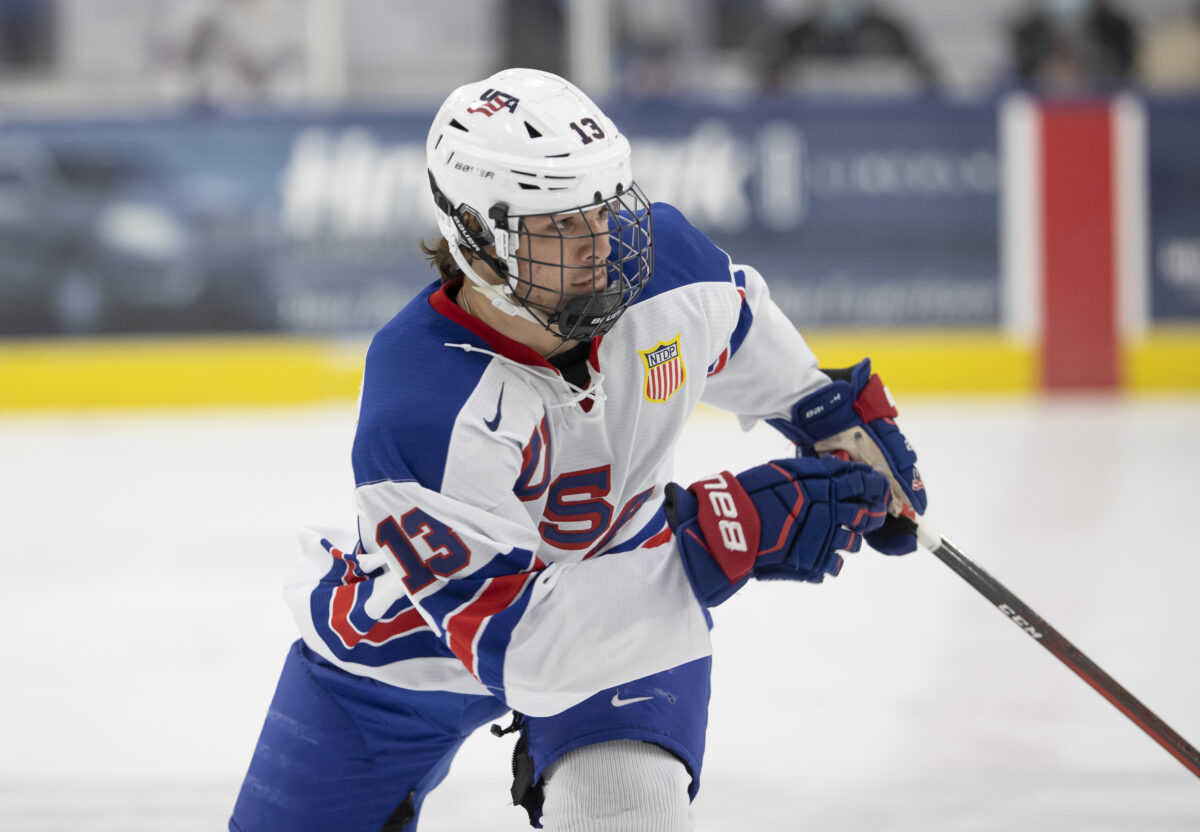
This will be a crucial year for Boucher, and nothing less than dominance at the OHL level is expected. Last season was chaotic for the young power forward, and with most of that behind him, his coaches expect him to show more of his skillset now that he’s more comfortable with the team and the systems with the Ottawa 67s. While he still doesn’t project to be much more than a middle-six winger in the NHL, he could become a devastating forward in the NHL if he’s able to round out his game and build on the things he excels at.
Tier 5: Mark Kastelic, Maxence Guenette, Cole Reinhardt, Oliver Johansson, Carson Latimer, Ben Roger, Rourke Chartier, Kevin Reidler, Theo Wallberg, Stephen Halliday, Cameron O’Neill
Mark Kastelic is the ideal tier-five player. He’s done everything the Senators have asked of him during his two seasons with the organization, and his hard work and dedication earned him a 16-game stint with the Senators last season. In that stint, he put up two goals and four points, won nearly 59 percent of his faceoffs, and recorded 51 hits, which made him a favourite to claim the fourth-line center spot for the 2022-23 season. He likely won’t ever emerge beyond that, but he also doesn’t have to; he’s an excellent depth player who makes the Senators’ fourth line a strength, not a weakness.
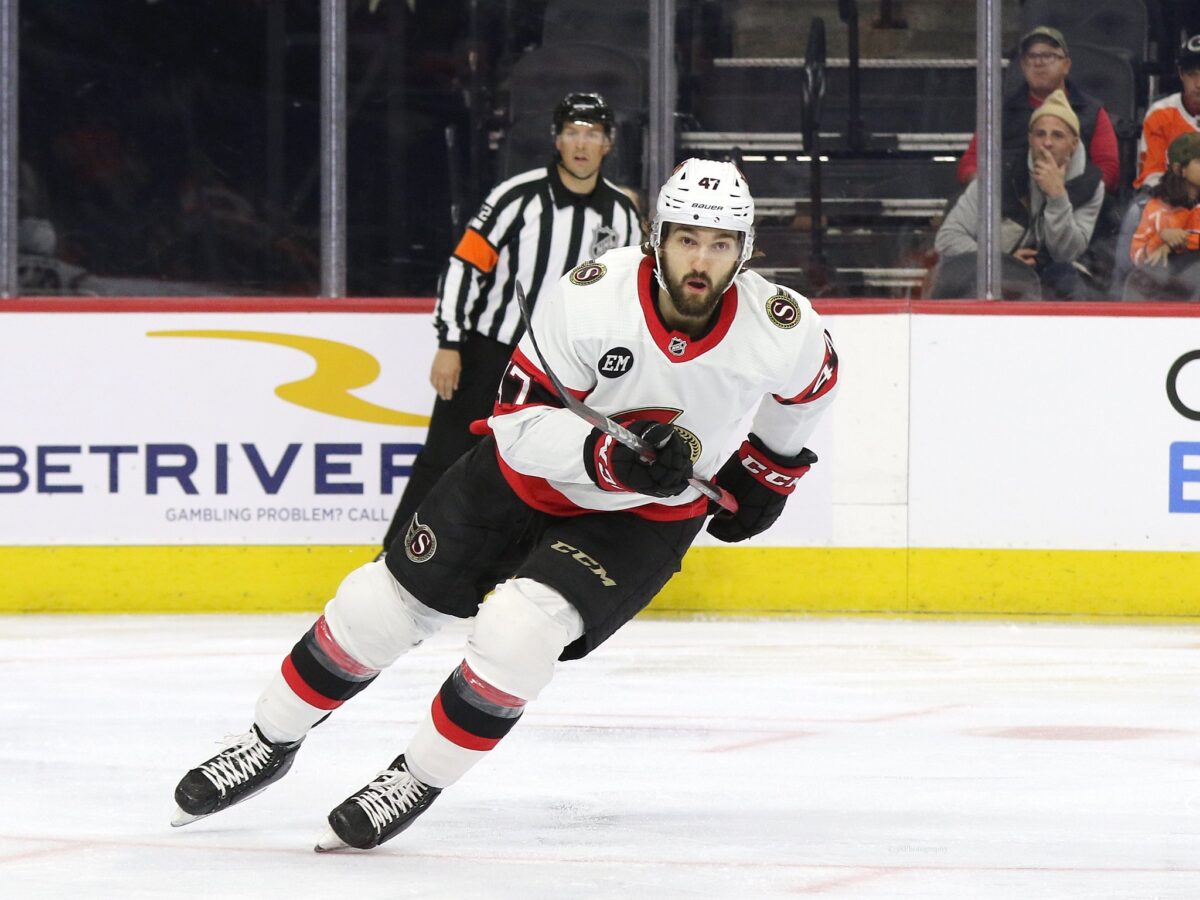
Cole Reinhardt is another prospect whose likely destined to play on the Senators’ fourth line. He has a limited offensive ceiling, but in his second season in the AHL, he recorded 15 goals and 30 points, which is nothing to sniff at. He’s a smart, responsible player who has experience on the penalty kill and getting into the dirty areas, which will make him a valuable checking-line player, but it would be very surprising if he emerged as anything more than that.
On defence, Maxence Guenette has been one of the Senators’ most surprising prospects, going from a seventh-round selection in 2019 to one of the team’s more promising defensive players. He made his AHL debut last season, playing 48 games and scoring six goals and 19 points. This season, he was named captain for the Senators’ rookie tournament in Buffalo in September, demonstrating his leadership abilities despite his young age. Better yet, he is a right-hand shot, which gives him a great chance at making the NHL, but his potential is limited to a depth role. Unless he can break out this season, he looks like he’ll be a bottom-pairing defender in the future.
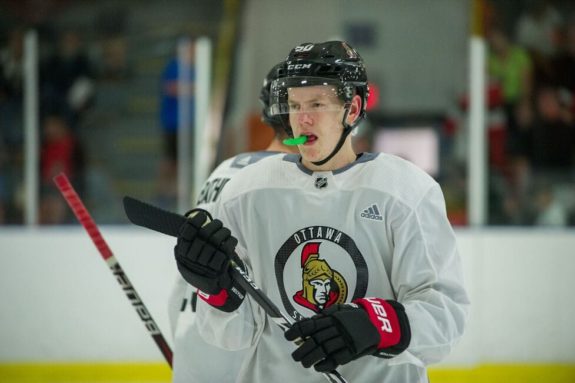
Kevin Mandolese has struggled to find a spot in the lineup in the past, and in last season’s goaltending logjam, he was lost in the shuffle and was sent down to the ECHL for a short time. However, now that Gustavsson and Matt Murray are gone, he’ll have a much better chance at securing the backup role in Bellville behind Sogaard. Former WHL All-Star and Senators’ camp invitee Logan Flodell may push him for minutes, and he will need to establish himself over him to remain relevant in the Senators’ organization.
Like Kleven and Nordberg, Ben Roger is practically guaranteed to make the NHL thanks to his size alone. The 2021 second-round pick is 6-foot-4, 201-pounds and is a decent skater for a bigger player. He has little offensive ability to speak of, however; in 55 games last season, split between the London Knights and Kingston Frontenacs, he had just one goal and 13 points. He’s demonstrated some leadership abilities, wearing an ‘A’ for the Knights in 2021-22 before being traded, but he won’t be much more than a bottom-pairing defenceman in the NHL.
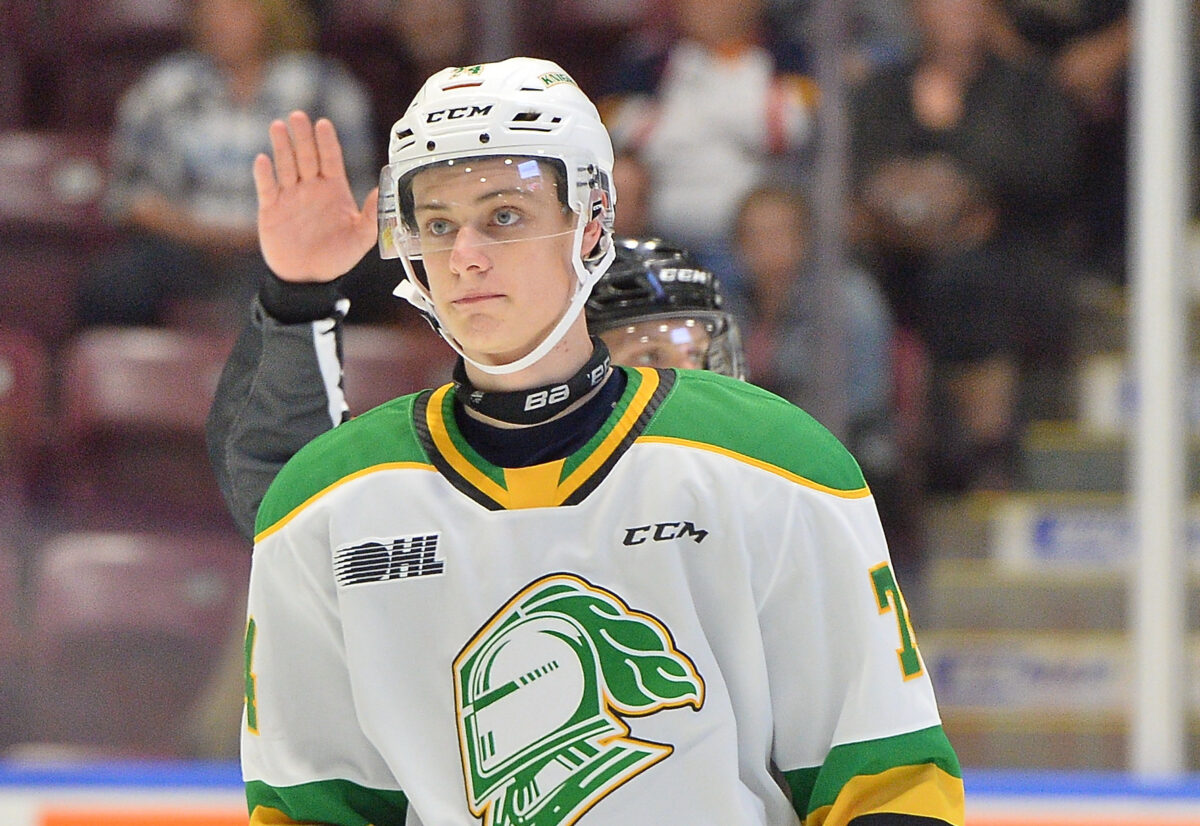
Carson Latimer, on the other hand, has shown great offensive instincts but struggled to do so consistently, especially after being traded from the Edmonton Oil Kings to the Prince Albert Raiders last season. While the Oil Kings went on to win the WHL Championship, the Raiders were out in the first round, which didn’t help showcase his skills as well. Still, 12 goals and 32 points in 44 games in a draft-plus-one season was a little disappointing. There are some strong defensive skills there, but he’ll need to become a more well-rounded player if he wants to earn an entry-level deal one day.
Oliver Johansson has yet to show his sneaky offensive skills beyond the junior level, and although he’s just 19 years old, more was hoped for from the 2020 third-round pick. He scored 41 points in Sweden’s U20 league last season, but in 14 SHL games, he was held scoreless. This season is more of the same story – in three U20 games, he already has five points, but in five SHL games, he has nothing. He’s a long-term project, so patience will be exercised with him, but he’ll need to show a bit more skill in the higher leagues if he wants to earn a contract to play in the NHL.
Although he’s new to the Senators, Rourke Chartier is familiar with the organization after spending all of 2021-22 with the Belleville Senators. It’s been a long journey for him after being drafted in 2014; once a promising prospect in the San Jose Sharks system, concussions and other injuries forced him to step away from hockey for all of the 2019-20 season. He returned to the AHL via the Toronto Marlies in 2020-21, but found much more success in Belleville, finishing last season with 10 goals and 25 points in 33 games. He’s likely an AHL forward at this point in his career, but the potential is there for him to claim a bottom-six role in the NHL.
The rest of the players in tier five are all 2022 Draft picks mainly due to the limited information we have on them so far. Kevin Reidler, a 6-foot-6 goalie from Sweden, was practically unheard of before the draft, which reminds me of Merilainen to some degree. However, he has played very little over the past couple of seasons, almost always serving as a backup or in a depth role. As such, he’s years away from making an impact.
Fellow Swede Theo Wallberg also has some intriguing potential and decided to come to North America for the 2022-23 season, joining the United States Hockey League’s (USHL) Dubuque Fighting Saints. At 6-foot-5, the lanky defenceman has a good shot at making the NHL, but will also be a long-term project; he’s committed to Ohio State University for the 2023-24 season.
Stephen Halliday was selected in the fourth round as an overage prospect and has a great blend of size and scoring abilities, but he hasn’t demonstrated his skill in a league higher than the USHL. He’s set to join Ohio State University in 2022-23, which means, he too is a long-term project but could become a solid bottom-six winger.
Cameron O’Neill was unbelievable in AAA last season, leading the league with 57 goals and 133 points in 62 games, leading all U18 players in points in 2021-22. This season, he’s with the USHL’s Tri-City Storm, where he already has three assists in two games, and has plans to join the University of Massachusetts in 2023-24. There’s a lot of potential in the Senator’s fifth-round pick, but also a lot of mystery; players drafted out of high school have a much longer road to the NHL than other prospects, but he’ll certainly be one to keep an eye on in the coming years.
Tier 6: Everyone Else
Players in this tier either are a long shot to make the NHL or have limited potential.
This includes Jonny Tychonick, Kristians Rubins, Jake Lucchini, Eric Engstrand, Jakov Novak, Luke Loheit, Olle Alsing, Jonathan Aspirot, Tyson Dyck, and Chandler Romeo.
Final Thoughts
While there are fewer names in the top tiers this year, the Senators’ prospect pyramid is still loaded with talent, many of whom are close to forcing themselves into the lineup. That may lead to some tough decisions in the future, especially with Ottawa’s core in place and locked up to long-term deals, but it’s arguably the best kind of problem they could have asked for. The Senators have done virtually everything right in their rebuild, practicing patience even as they failed to live up to their low expectations, and now they’re reaping the benefits. The rebuild is all but over, and now fans will get to watch their team emerge as one of the toughest to beat in the Eastern Conference over the next several seasons.